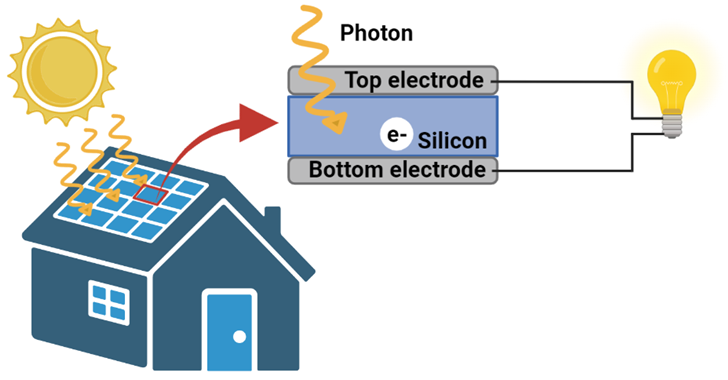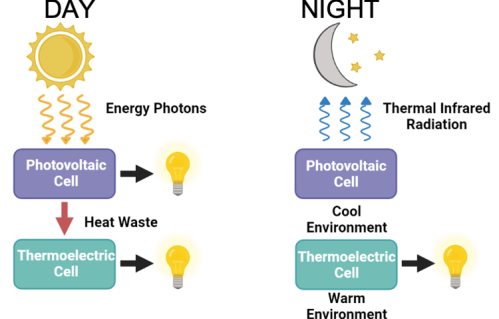The dwindling supply of non-renewable energy sources (I’m looking at you, fossil fuels!) and their impact on the environment have driven the pursuit for more sustainable energy sources. 1 According to the International Energy Agency, global energy demands decreased by 1% in 2020 due to the COVID-19 pandemic, but this statistic is quickly turning around, with an expected increase of 5% in 2021 and 4% in 2022. Despite steady increases in the use of renewable energy sources such as solar power, it is predicted that renewables will only be able to support about half the projected global demands in the next couple of years. 2

One of the challenges for solar energy is that commercial solar panels need direct sunlight to achieve peak performance. This means that cloudy days and other weather changes can impact how much sun they are exposed to and thus how much electricity they produce. In addition to this, solar panels are not able to generate electricity at night. 3 This begs the question: is there a way to supplement solar panels when they are surrounded by darkness? Before we dive into that question, let’s talk about how solar panels generate electricity.
How do solar panels work?
First, it is important to mention that photons and electrons are the two particles that allow solar panels to generate electricity. The light energy from the sun is quantized into photons, and electrons are negatively charged particles that act as carriers for electricity in materials. Now let’s talk about the role these two particles play in the generation of electricity in solar panels.
Commercial solar panels are arrays of photovoltaic cells that have semiconductors like silicon as their active material. Through the photovoltaic effect, these cells use light photons from the sun to generate electrons in the active material. These electrons can then travel through the material and produce a voltage. (This technology does have a connection to nanoscience: there is research being done on nanoscale thin film cells, for example, but they aren’t the commercial standard right now because of material availability and manufacturing costs. 4)

Solar panels used today are about 15-20% efficient at taking absorbed light energy and converting it to electrical energy that we can use. 5 Part of this inefficiency is because photovoltaic cells generate heat that is lost to the surrounding environment. If the light energy lost to heat in photovoltaic cells could be harnessed too, then we could use solar rays more efficiently. Energy production for photovoltaic cells is also limited to the daytime when panels are surrounded by an abundance of sunshine. This leaves a large chunk of time at night where the sun’s energy cannot be harvested. There is a different type of cell, however, that could increase the efficiency of solar energy conversion and even provide some electricity despite the darkness.
How can we generate electricity in the dark?
Thermoelectric cells accomplish energy conversion through the Seebeck effect. This phenomenon produces a voltage between two different electrical conductors (like metals) or semiconductors (like silicon) because there is a temperature difference between them. In the spirit of increasing efficiency, researchers have developed a hybrid photovoltaic-thermoelectric cell that can produce electricity both during the day and at night.
One team of researchers from China and the UK recently demonstrated that a photovoltaic-thermoelectric device was able to generate 9 millivolts of electricity at night.6 This is a pretty tiny voltage (less than the electricity needed to power a twinkle light), but it is proof that darkness does not have to stop the production of electricity in photovoltaic devices! In this hybrid cell, the photovoltaic cell uses solar energy during the day to produce electricity and waste heat, and the thermoelectric cell can convert some of the waste heat to more electricity. Hello, increased efficiency of daytime solar energy conversion!
Then at night while the photovoltaic cell isn’t getting any sunlight, the thermoelectric cell can keep generating a voltage based on the temperature difference across the materials it is sandwiched between. This is possible because the photovoltaic cell located above the thermoelectric cell emits infrared thermal radiation into space even at night (similar to how a rock that has been heated by the sun will keep giving off heat after dark). That means it is constantly cooler than the surface that is underneath the thermoelectric cell.6 Essentially, the constant cooling of the photovoltaic cell creates the temperature difference the thermoelectric cell needs to produce electricity. Talk about a collaborative cycle!

As with any new and promising device in research, future efforts will be needed to delve into increasing the efficiency and capability of photovoltaic-thermoelectric hybrid type solar cells. Devices like these could help supply the increasing energy needs of the world in a more sustainable way. If you ask me, it’s awesome that the night sky is no longer the limit!
References
- Kannan, N. & Vakeesan, D. Solar energy for future world: – A review. Renewable and Sustainable Energy Reviews. 2016, 62: 1092-1105. DOI: 10.1016/j.rser.2016.05.022
- IEA. Press Release: Global electricity demand is growing faster than renewables, driving strong increase in generation from fossil fuels. 2021. Retrieved from: https://www.iea.org/news/global-electricity-demand-is-growing-faster-than-renewables-driving-strong-increase-in-generation-from-fossil-fuels
- Sendy, A. Do solar panels work on cloudy days or at night? Solar Reviews. 2021. Retrieved from: https://www.solarreviews.com/blog/do-solar-panels-work-on-cloudy-days-or-at-night
- Kumar, N. et al. Chapter 10: Nanomaterials for advanced photovoltaic cells. Micro and Nano Technologies. 2021: 239-258. DOI: 10.1016/B978-0-12-821346-9.00006-7
- Rappaport, P. The photovoltaic effect and its utilization. Solar Energy. 1959 3(4): 8-18. DOI: 10.1016/0038-092X(59)90002-7
- Zhao, B. et al. Is it possible for a photovoltaic-thermoelectric device to generate electricity at night? Solar Energy Materials and Solar Cells. 2021, 228. DOI: 10.1016/j.solmat.2021.111136
